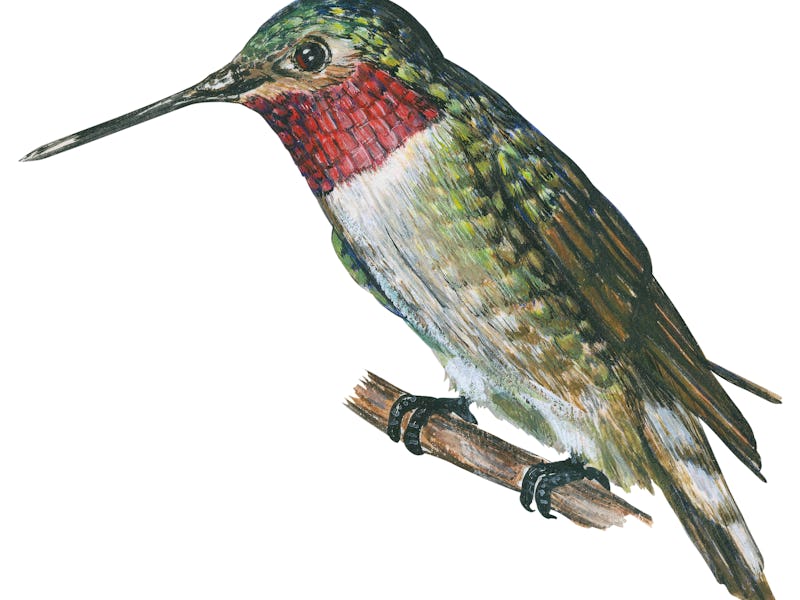Wild hummingbirds can see colors that humans can't — study
Having visual superpowers makes for a more successful life.

Though tiny and delicate, hummingbirds are keen at adapting to their environment — whether building a nest with a leaf as a roof or using their expert eyes to scout out their surroundings.
Hummingbirds are also able to see colors that humans can't — and that gives them an edge when it comes to foraging, mating, and avoiding predators, a new study finds.
Researchers report that broad-tailed hummingbirds can differentiate between colors outside of the human spectrum — when these hummingbirds look at objects like plants and bird plumage, they see colors that we do not. Colors outside of the classic rainbow may account for one-third of what hummingbirds survey.
This finding was published Monday in the journal Proceedings of the National Academy of Sciences.
In the eyes of animals, including humans, cells called cones and rods take in light. While rods deal with the intensity of light — making it possible to see in low light, for instance — cones help one perceive color.
Humans have three types of cones, which respectively allow us to see blue, red, and green. Thanks to that ability, the full spectrum of colors that humans see include red, orange, green, blue, indigo, and violet. But we can also see combinations of colors from widely separated parts of the spectrum — like purple, which combines red and blue.
Birds, meanwhile, have four types of cones, so their color-combination possibilities are multiplied, compared to humans.
In this study, researchers conducted experiments with broad-tailed hummingbirds, Selasphorus platycercus, to see whether the birds could differentiate between spectral colors and spectral colors combined with UV. The goal was to evaluate how important nonspectral colors are to these birds.
A male broad-tailed hummingbird at the laboratory where the experiments took place.
The researchers used a sugar solution as a reward. For example, they tested hummingbirds to see if they could tell the difference between a green light and green light combined with UV light, based on whether they could access the reward.
Humans can't see UV light, but birds can. By combining spectral light with UV, researchers proved that birds can differentiate between those colors. This means that when the birds look at objects we can see as spectral light, they are likely seeing many more colors because that fourth cone gives the ability to see more color combinations.
Putting vision to use — The ability to see such an array of colors might be particularly important for hummingbirds because the colors that fall outside the spectrum of light are surprisingly common in both the plumage and the plants that hummingbirds are interested in.
Cones help animals see color; birds have four types of cones, while humans have three.
In a separate analysis from the vision experiments, the same researchers looked at 965 bird plumage specimens and 2,350 plant samples. They discovered that 30 percent of plumage and 35 percent of plant colors are actually nonspectral — making the ability to distinguish these colors responsible for a significant amount of hummingbirds' vision.
That means that "birds perceive many natural colors as nonspectral," the study authors write. When hummingbirds are flapping through the backyard, they may be seeing a very different world than their human counterparts.
Abstract: Many animals have the potential to discriminate nonspectral colors. For humans, purple is the clearest example of a nonspectral color. It is perceived when two color cone types in the retina (blue and red) with nonadjacent spectral sensitivity curves are predominantly stimulated. Purple is considered nonspectral because no monochromatic light (such as from a rainbow) can evoke this simultaneous stimulation. Except in primates and bees, few behavioral experiments have directly examined nonspectral color discrimination, and little is known about nonspectral color perception in animals with more than three types of color photoreceptors. Birds have four color cone types (compared to three in humans) and might perceive additional nonspectral colors such as UV+red and UV+green. Can birds discriminate nonspectral colors, and are these colors behaviorally and ecologically relevant? Here, using comprehensive behavioral experiments, we show that wild hummingbirds can discriminate a variety of nonspectral colors. We also show that hummingbirds, relative to humans, likely perceive a greater proportion of natural colors as nonspectral. Our analysis of plumage and plant spectra reveals many colors that would be perceived as nonspectral by birds but not by humans: Birds’ extra cone type allows them not just to see UV light but also to discriminate additional nonspectral colors. Our results support the idea that birds can distinguish colors throughout tetrachromatic color space and indicate that nonspectral color perception is vital for signaling and foraging. Since tetrachromacy appears to have evolved early in vertebrates, this capacity for rich nonspectral color perception is likely widespread.
This article was originally published on